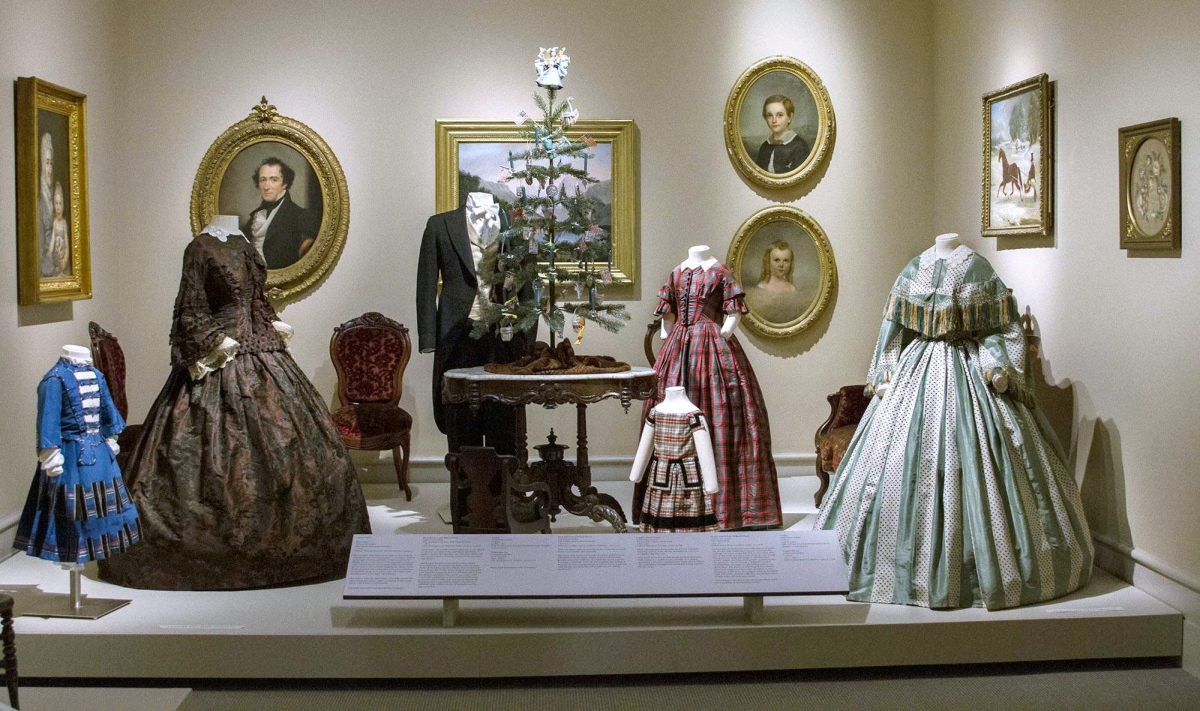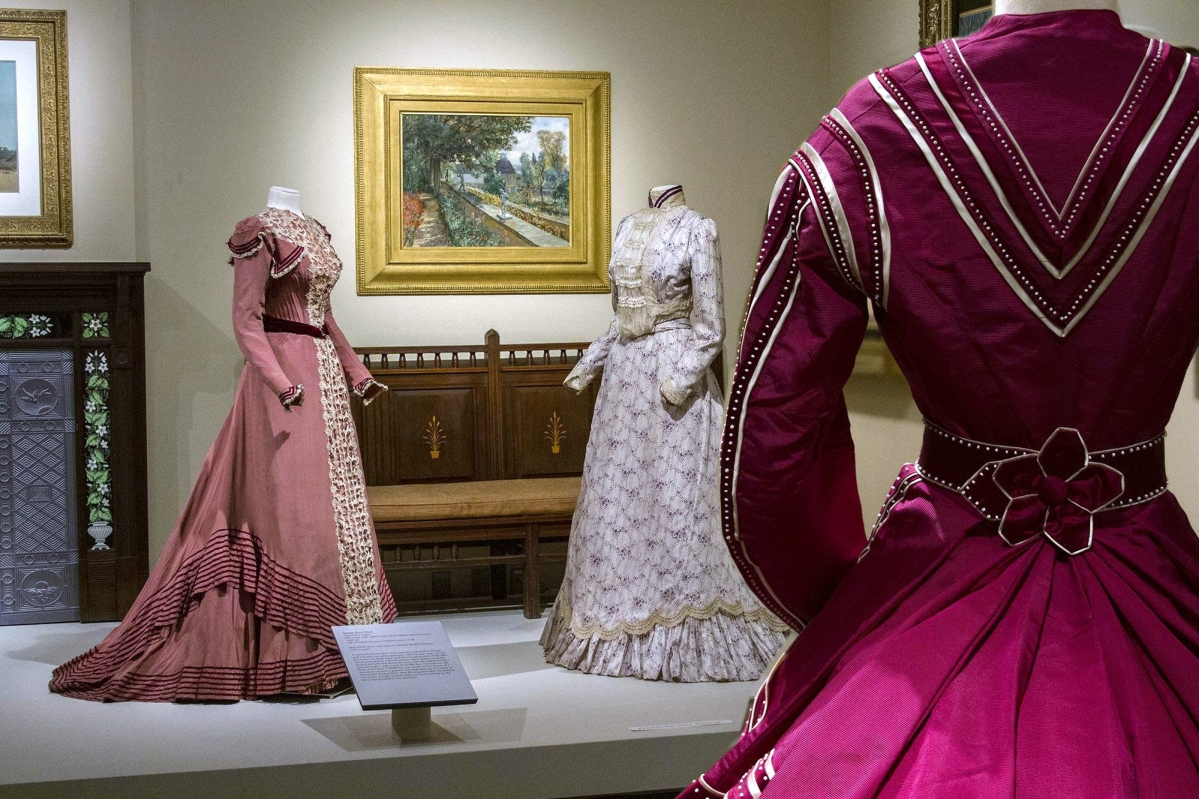
From left, boy’s suit, unknown maker, circa 1860; rust brown and black dress, unknown maker, circa 1853; man’s suit courtesy of The Costumer, Schenectady, N.Y.; girl’s red and green plaid dress, unknown maker, 1855–65; child’s plaid dress, unknown maker, 1840–50; and green and white striped dress, unknown maker, 1853–57, silk with fringe. The table is by Hertz and Lehmann, Albany, N.Y., circa 1862.
By Diane Shewchuk
ALBANY, N.Y. – Forty-six mannequins dressed in garments made between 1842 and 1901 are featured in the exhibition “Well-Dressed in Victorian Albany,” on view at the Albany Institute of History and Art through May 20. Founded in 1791, the Albany Institute, one of the oldest museums in the United States, is dedicated to collecting and interpreting the art, history and culture of the Upper Hudson Valley from the late Seventeenth Century to the present. The museum is especially known for its Hudson River School paintings and a pair of Egyptian mummies acquired in 1909.
In this special exhibition, the museum gives center stage to its little-known but spectacular collection of Nineteenth Century clothing. The show gives visitors the rare opportunity to see a small selection of what has been hiding in the museum’s closets.
In five large galleries, “Well-Dressed in Victorian Albany” showcases an extraordinary selection of dresses made of luxurious, vibrantly colored fabrics and sewn by home seamstresses, professional dressmakers and couturiers. Worn by middle- and upper-class women and children in the Capital Region, Hudson Valley and beyond, the costumes tell stories of notable New Yorkers and illuminate their world of fashionable affluence. From wedding gowns to walking suits, these garments reflect the evolution of fashion as well as the social and technological changes that took place during the reign of the British monarch Queen Victoria between 1837 and 1901. A diversity of shapes and silhouettes, among them the bustle and leg-of-mutton sleeve, reflect the dramatic evolution in the style of each decade.
Suggesting scenes of Nineteenth Century domestic life, the garments are displayed with objects from the institute’s collections of paintings, furniture and decorative arts. The addition of such works creates an atmospheric context to the display. Rarely exhibited artifacts include an 1890s wicker baby carriage and a Thonet bentwood settee.
Paintings by George Henry Boughton, Charles Loring Elliott, Will H. Low and Elihu Vedder accompany the presentation. Walter Launt Palmer’s 1892 masterpiece “Autumn Morning -Mist Clearing Away,” a first-prize winner at the World’s Columbian Exposition, enhances the golden tones of the dresses selected to represent the mid-1890s. An armchair by Léon Marcotte, a rosewood Rococo Revival parlor suite and a Renaissance Revival pier mirror enhance the settings. A Walter Launt Palmer painting of Venice was enlarged as a wall graphic, setting the stage for a Grand Tour scene complete with an 1890s Louis Vuitton trunk bearing the initials of Mary DeCamp Corning.
 A small gallery has been outfitted as a mid-Nineteenth Century parlor decorated for Christmas, a scene inspired by an engraving of Queen Victoria, Prince Albert and their children at Windsor Castle. The engraving appeared in the 1848 London Illustrated News. The three children’s mannequins in this gallery wear outfits featuring plaid fabrics, a fashion trend inspired by Queen Victoria’s 1851 purchase of Balmoral Castle, her retreat in the Scottish Highlands. The most striking of the three garments in this scene is a hand-stitched, two-piece kilted suit worn around 1860 by William Bayard Van Rensselaer (1856-1909) of Albany.
A small gallery has been outfitted as a mid-Nineteenth Century parlor decorated for Christmas, a scene inspired by an engraving of Queen Victoria, Prince Albert and their children at Windsor Castle. The engraving appeared in the 1848 London Illustrated News. The three children’s mannequins in this gallery wear outfits featuring plaid fabrics, a fashion trend inspired by Queen Victoria’s 1851 purchase of Balmoral Castle, her retreat in the Scottish Highlands. The most striking of the three garments in this scene is a hand-stitched, two-piece kilted suit worn around 1860 by William Bayard Van Rensselaer (1856-1909) of Albany.
In a vignette representing a Civil War parlor, an oval framed wreath made of hair hangs behind a boldly striped lilac and black dress denoting half-mourning. This dress was made of a silk fabric woven in wide bands of faille and satin to absorb and reflect light. The width of the skirt was supported by a steel-cage crinoline and the pagoda-shaped sleeves are edged on the inside with a pleated black silk ribbon.
Other fashion highlights include seven ensembles owned by the fashion-conscious Mary Augusta Green De Camp Corning (1843-1935), wife of Edwin Weld Corning (1836-1871). The couple married in Saratoga Springs in 1866 and embarked on a European tour. Their trip was probably financed by the groom’s father, Erastus Corning I, who gave the young bride a check for $20,000 as a wedding gift. When the couple reached Paris, Mary went shopping. Like other wealthy Americans, she patronized the foremost French fashion houses. As a young matron moving in society, Mary needed a wardrobe appropriate to her lifestyle in Newport, New York City, Saratoga Springs and Albany.
She acquired two outfits from Worth & Bobergh, an establishment founded in Paris by the English designer Charles Frederick Worth and his Swedish business partner, Otto Bobergh. One was a charming Louis XVI-style walking suit in a tasteful combination of brown silk taffeta and gray silk faille. The other was a pale blue silk afternoon dress decorated with bias-cut, shirred ruffles arranged in scallops around the hem. From Emile Pingat, another Parisian couturier favored by Americans, Mary purchased a showstopping coral-pink silk ball gown trimmed with beads and pearls.
During this period, Mary also bought dresses from French dressmakers working in New York City, including two ensembles by Marie and Josephine Virfolet. Mary made a grand entrance and exit wearing a celestial blue and cream silk ball gown at “the Ball Father and Mother gave me in February 1867.” The Virfolet sisters, skilled in garment construction and ornamentation, also created for Mary a magnificent raspberry-colored ribbed silk dress accented with white glass seed beads. The shocking vibrancy of the color was possible because a decade earlier English chemist William Henry Perkins invented the first aniline dye, which transformed the history of color in fashion. This dress is decorated with white satin and magenta-colored ribbed silk, making it stunning from any angle.

Left, smoky-rose dress, 1898-99, and, right, violet and white dress, circa 1899, makers unknown. Foreground, back of raspberry dress with white beads by Marie and Josephine Virfolet, New York City, 1867. Rear, “The Terrace Walls” by Will Hicok Low (1853–1932), 1901, oil on canvas.
Two other dresses worn by Mary Corning represent the 1870s. They are a gray-blue visiting dress labeled by the House of Worth and a walking dress edged with deep fringe made in New York City by Maison Frédériqua. Mary may have seen a small advertisement in The New York Times that stated that Madame A.P. Provot of Maison Frédériqua “informs her customers and ladies in general that she has just returned from Paris with the latest Styles and Novelties for Dresses.”
The exhibition showcases dresses made by other leading Paris fashion houses of the day, including two by the House of Felix. A sensational yellow and brown plaid example by Ernest Raudnitz has voluminous leg-of-mutton sleeves measuring 60 inches in circumference. A lace-covered frothy creation by Callot Soeurs was worn around 1895 by Martha Innis Young (1856-1946), a fixture of Poughkeepsie, N.Y., society.
The unlabeled garments on view are not to be outdone by their known French and New York City counterparts. One of the most sophisticated creations in the exhibition was worn by Katharine Livingston Stuyvesant (1844-1891) on April 9, 1874, at her wedding to Francis Reed Butler in Hyde Park, N.Y. A few years later, the dress was altered to its current state, a dinner dress with the addition of brocade panels and rows of satin pleats stitched diagonally along the bottom of the skirt and train.
An elegant ivory wool walking suit of 1901 looks deceptively simple in construction. The jacket was designed to puff out over the waist in a “pigeon breast” shape and the decorative top-stitching is sophisticated in design and technique.
The six wedding gowns in the exhibition, which range from the 1840s to the 1890s, are set against backdrops of enlarged period fashion plates from publications such as Godey’s Ladies’ Book and La Mode Illustrée. A claret-colored wedding gown and a green wedding gown reinforce the notion that during this period a woman sometimes wore her Sunday best for the ceremony. It was Queen Victoria who popularized the idea of white as a fashionable color choice for a wedding gown.
Garments like the ones in this exhibition survived because of their sentimental associations, their aesthetic beauty and sometimes by chance, because they were put away and forgotten. Walking through the galleries provides many revelations. The waist sizes – which measure from 19 to 26 inches – remind us of the restrictive undergarments of the era. We see, too, the brilliance of technique: how fabric can be ruched, pleated, gathered, embellished and manipulated into sculptural silhouettes. The black and white world of Victorian photographs becomes one of lush amethyst velvet, royal-blue taffeta, cranberry silk and emerald-green velveteen.
The Albany Institute of History and Art is at 125 Washington Avenue. For information, 518-463-4478 or www.albanyinstitute.org.
Diane Shewchuk is curator, Albany Institute of History and Art.



















